Jeep Dashboard Warning Lights & Symbols
Jeeps are known for their rugged durability and off-road capabilities, but even the toughest vehicles need regular maintenance and check-ups. One important aspect of maintaining your Jeep is awareness of the various dashboard symbols and warning lights. These symbols and lights are designed to alert you to potential problems with your vehicle, and it’s essential to understand what they mean and how to respond to them. In this guide, we’ll explain the most common dashboard symbols and warning lights that you’ll see on your Jeep, so you’ll know what to do when they pop up. We will also provide an overview of what causes them and what actions you should take to resolve the issues. Understanding these symbols and warning lights can help you keep your Jeep in top condition and make sure you’re always aware of any potential problems.
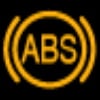 Anti-Lock Brake System Fault This light means that the anti-lock brake system has been disabled. In most cases, the problem is due to a bad ABS wheel speed sensor. While the vehicle can be driven with the anti-lock brake function is disabled, the vehicle may take longer to bring to a complete stop and may skid under hard braking or if it is raining or there is snow on the road. Use an ABS scanner to read the ABS Control Module’s fault codes to determine why your Jeep ABS light is on. Generic OBD-II scanners may not be able to read airbag scanners. |
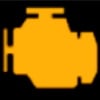   Check Engine Light / Service Engine Soon The check engine light (CEL) is a warning light that appears on the dashboard of a Jeep when there is an issue with the vehicle’s powertrain or emissions system. The powertrain includes the engine, transmission, and other related components, while the emissions system includes the catalytic converter, oxygen sensors, and other parts that control the vehicle’s emissions output. When the CEL is illuminated, the vehicle’s onboard computer (also known as the Engine Control Module or ECM) has detected a problem that needs attention.The cause of a check engine light can vary widely, and it can be something as simple as a loose gas cap, a malfunctioning sensor, or a more serious issue like a problem with the engine or transmission. A fault code is stored in the Engine Control Unit (ECU) and retrieved with an OBD-II scanner to determine what is wrong with the vehicle. |
 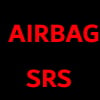 Air Bag Warning Light The airbag light turns on when you first turn on the ignition, but after a quick system check, it turns off if all the airbag components function properly. If the airbag light stays, it means the airbags have been disabled and may not deploy in case of an accident.To troubleshoot the airbag light on, you will need to read the fault codes with an airbag scanner. |
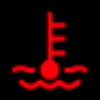 Engine Temperature This is the warning symbol that indicates that the engine has overheated. Pull over immediately and shut off the engine. Wait at least 30 minutes or more for the engine to cool down fully. Once the engine cools down, check the engine coolant level. Common problems that cause a Jeep engine to overheat include low coolant level, bad water pump, broken coolant hoses, a faulty thermostat, a damaged heater core, etc. If the engine overheating continues, do not drive. Call an auto mechanic for advice or tow the vehicle to an auto repair shop near you. |
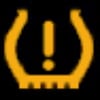 Tire Pressure Monitor / TPMS This light means there is low tire pressure in one of the tires. Check the tire pressure and correct it to the recommended air pressure, as shown on the driver’s door frame sticker. Typically 35 PSI. If the TPMS light stays on after adding air, there may be a problem communicating with one of the TPMS sensors, or the TPMS system is faulty. |
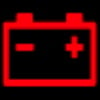 Battey Light / Charge System The battery warns the driver there is a problem with the charging system. The vehicle may shut off when driving if the battery light comes on. The battery warning light can be caused by a faulty alternator, a serpentine belt problem, a defective voltage regulator, and even a bad battery. |
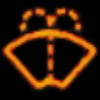 Low Washer Fluid This light means that the fuel level is low. Add windshield washer fluid to the reservoir in the engine bay. The windshield washer fluid reservoir has the same symbol on top. |
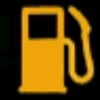 Low Fuel This light means that the fuel level is low, and you need to add fuel. |
 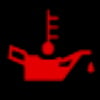 Oil Warning Light This light means there is low oil pressure. Pull over immediately and shut off the engine. Wait at least 5 minutes, then check the oil level with the engine off. If the oil level is low, add engine oil to bring the level between the MIN and MAX marks of the dipstick. Do not drive the vehicle or keep the engine running if the oil light stays on. Doing so can lead to serious engine problems. Call an auto mechanic for advice or tow the vehicle to a repair shop nearby. |
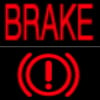 Brake Light This light indicates a problem with the brake system. It could be due to a low brake fluid level or another issue with the brake system. Do not drive with the BRAKE light on. Brakes may not work or function properly. Call an auto mechanic for advice and, if needed, tow the vehicle to the closest auto repair shop. |
 High Beam This light means the high beams are turned on. You should only use this setting if you are the only vehicle on the road. Do not keep the high beams on in city driving. To turn off the high beam, pull the turn switch towards you. |
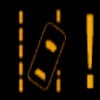 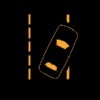 Lane Keeping This light means that lane assist is enabled. This light should flash if you leave the lane without turning on the blinker. |
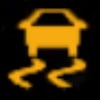 Stability Control This light means that the stability control has been disabled. The vehicle can be driven but keep in mind stability control is off. In most cases, this light comes on at the same time that the ABS light comes on. If that is the case, there is a high chance one of the wheel speed sensors is faulty. Use an ABS Scanner to read the fault codes from the ABS and traction modules. |
 Electronic Power Steering Trouble This light means there is a problem with the electronic power steering. The steering wheel may be tough to turn. |
 Turn Signal This light means the turn signals are on. If both turn signals are flashing, it is because the hazard lights are turned on. Turn off the hazard by pressing the orange triangle on the dashboard. |
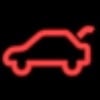 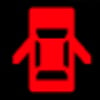 Door Or Gate Ajar This light means that one of the doors is open or is not closed completely. Pull over, park the vehicle and check to ensure all the doors are fully closed. |
 Park Lamps ON This light means the parking lights have been turned on. Typically the low beam switch controls the parking lights. Turn the switch one more click to turn on the low beams. |
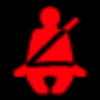 Seat Belt Reminder This light means that one or more passenger in the vehicle has not fastened the seat belt. |
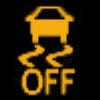 Stability Control OFF This light means that stability control has been turned off. Stability control may have been turned off because you pressed the button on the dashboard or a problem with the system. |
 Security This light means that the vehicle security system is activated. To disable, unlock the vehicle and insert a key in the ignition. If the light stays on, the transponder in your key may be faulty. |
 Fog Lamp This light means that the fog lights are turned on. Fog lights are mounted on the lower part of the front bumper. |
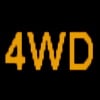 4 Wheel Drive This light can either the 4WD is activated, or if it is flashing, there is a problem with the 4WD system. |
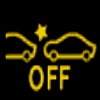 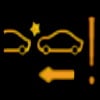 Forward Collision Alert This light means that the forward collision system has been turned off or disabled due to an internal problem. |
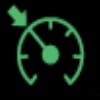 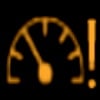 Cruise Control This light means that cruise control has been enabled. The vehicle will keep a constant speed. Cruise control will turn off if you press the brakes. Note that in this case, there is no adaptive cruise control. The vehicle will not keep a safe distance from the vehicle in front. |
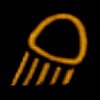 Cargo Lights ON This light means that the rear cargo light is turned on. |
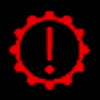 Transmission Fault This light means that there is a problem with the automatic transmission. When this light stays on, the transmission may get stuck in gear, not shift, or you may experience erratic shifting. Do not drive with this light on, or you may cause further damage to the automatic transmission. Use a Transmission Scanner to read the codes stored in the Transmission Control Module (TCM). |
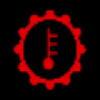 Transmission Oil Temperature This light means that the transmission fluid has overheated. This light often comes up if you are towing with your Jeep. If that is the case, pull over and allow the transmission to cool down. |
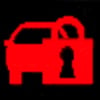 Immobilizer Fault This light means that the vehicle is locked, and the security system is activated. If this light comes on when you try to start the vehicle, the key is not recognized. |
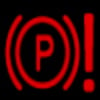 Electric Park Brake This light means that there is a problem with the parking brakes. |
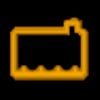 Low Coolant This light means that the engine coolant level is low. Do not drive with this light on. Pullover as soon as it is safe to do so. Allow the engine to cool down, then check the engine coolant level. |
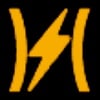 Electronic Throttle Control This light means that there is a problem with the electronic throttle. In most cases, this light comes on because the throttle body is defective or the gas/accelerator pedal is faulty. The vehicle has no power and may not respond when pressing the gas pedal when this light comes on. |
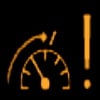 Active Speed Limiter This light means that the vehicle’s speed has been limited. |
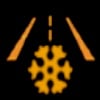 Slippery Conditions This light means that the outside temperature is below freezing. Slow down and drive carefully to avoid slipping. |
 Sway Bar Fault It is possible to disconnect the Sway Bar electronically on some Jeep vehicles, which allows for better traction in off-road conditions. If an exclamation mark shows next to the sway bar, it means there is a problem, and the sway bar can not disconnect or reconnect. |
 Glow Plug This light comes on a diesel engine when you first turn the ignition. It stays on for about five seconds, then turns off. This is normal. You should wait for this light to turn off then start the engine. If the glow plug light stays on, there is a problem with the glow system. Most likely, one of the glow plugs is bad. |
 Low Diesel Exhaust Fluid This light means that you need to add DPF fluid. |
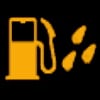 Water In Fuel This light means there is water contamination in fuel. |
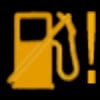 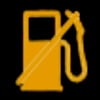 Shut Off The fuel pump symbol with a line across comes when the vehicle cuts the fuel to the engine. This typically happens if the vehicle detects an accident. The engine will not start. The vehicle may need to tow to an auto mechanic. |
 Start-Stop System Fault Just the A with an arrow means that engine auto start/stop is enabled. If an exclamation mark is shown next to the symbol, this function is disabled, typically due to a problem. |
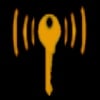 KeySense Indicator If this light comes on, the vehicle is not detecting a key. Check the batteries in your keyfob and replace them if necessary. |
 Sound System Fault This light means that no sound can be played through the speakers due to a sound system problem. |
 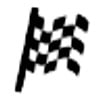 Sport Mode This light means that the engine and transmission are in sport mode to deliver the best performance. |
 Valet Mode This light leaves the door open and ignition on for valet parking. |
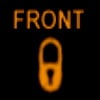  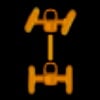  Axle Lock This light means the front or rear axle is locked in all-wheel mode. If the exclamation is present, the all-wheel drive can not be activated due to a problem with the system. |
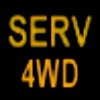 4 Wheel Drive Fault This light means there is a problem with the all-wheel-drive system. You need to service the 4WD system. |
 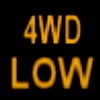 4 LOW This light means that the all-wheel drive is in low-range mode. This is only needed in off-roading situations. |
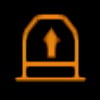 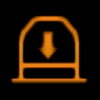   Suspension Setting This light means vehicle height has been adjusted. Lowered or raised depending on the arrow’s direction. |
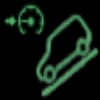 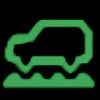 Grade and Terrain Assist This light means that the rade assist has been enabled. This can be helpful in off-road situations. |
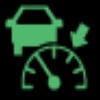 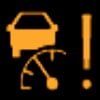   Adaptive Cruise Control This light means that adaptive cruise control has been activated. If the light is yellow with exclamation marks, there is a problem with adaptive cruise control. |
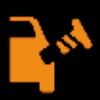 Loose Gas Cap This light means the gas cap is missing or is loose. Check the gas cap and tighten it. The check engine will also turn on if you drive with no gas cap. |
Many of these lights on a Jeep are meant to inform the driver when a system is enabled. A few of these lights indicate a problem or malfunction and inform the driver that that particular system has been disabled.
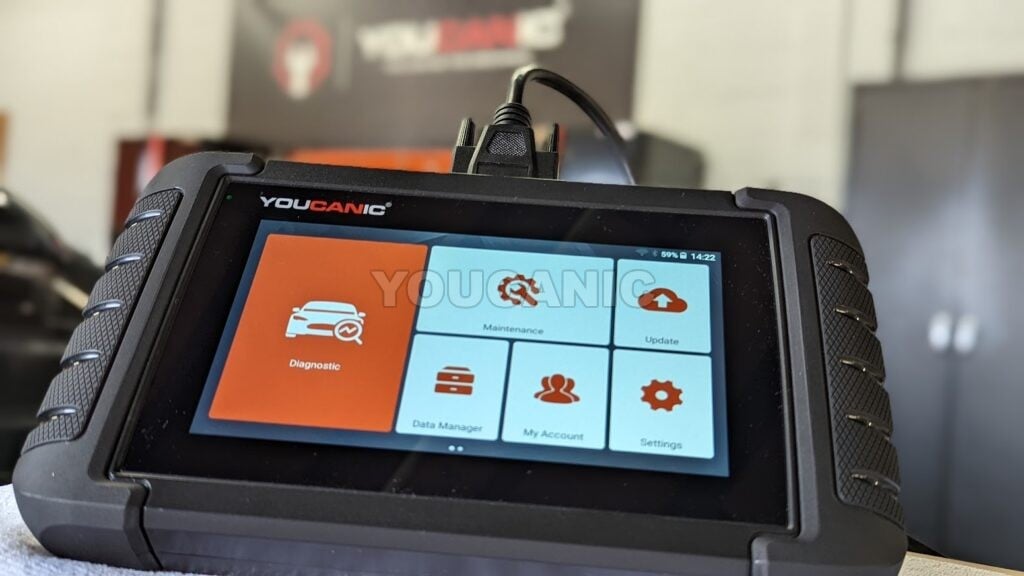
To find out what is wrong with these systems, use an All System Jeep Scanner to read the corresponding module’s fault codes. Most OBD-II scanners can only reach check engine codes and not diagnose other systems such as airbags, ABS, traction control, etc.
Frequently Asked Questions
What is the most serious warning light?
The check engine light is the most serious warning light that may appear on your vehicle’s dashboard. It indicates potential serious damage to your engine.
When should I worry about dashboard lights?
Red Warning Light: Needs Immediate Action
Orange/Amber Warning Light: This can be checked in your garage.
What scanner should I use to diagnose warning lights?
You can use the YOUCANIC Full System Scanner to diagnose all vehicle trouble codes. Generic OBD-II Scanners can only read and clear fault codes on the ECU, but on other control modules, it won’t work.
We hope you find the Jeep Dashboard Warning Lights and Symbols guide helpful. Check these troubleshooting and repair guides for more help on your Jeep.



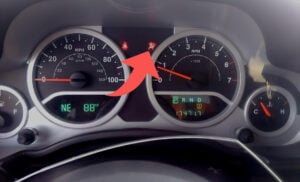

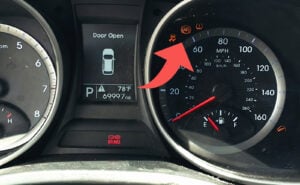

What does RUN on dashboard mean?